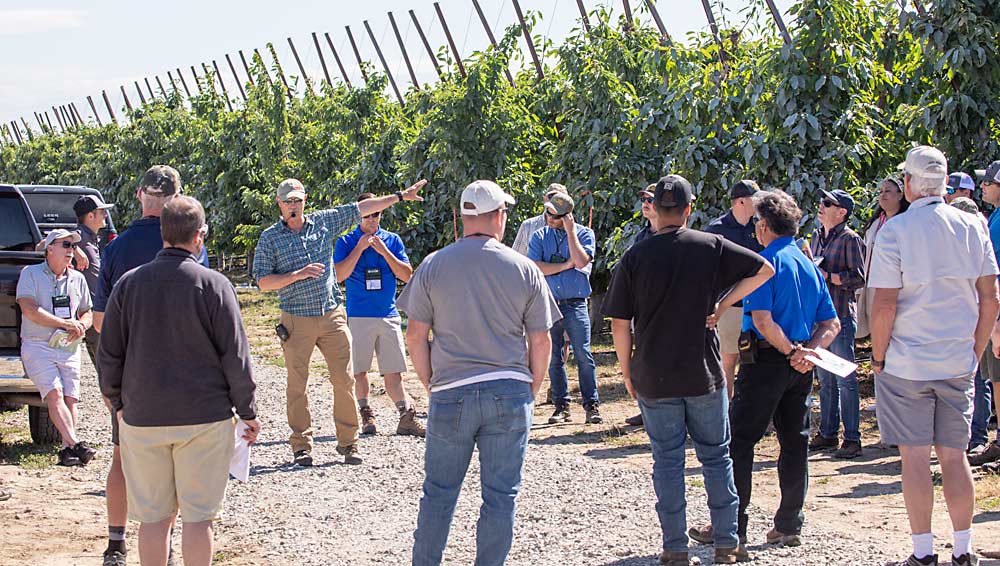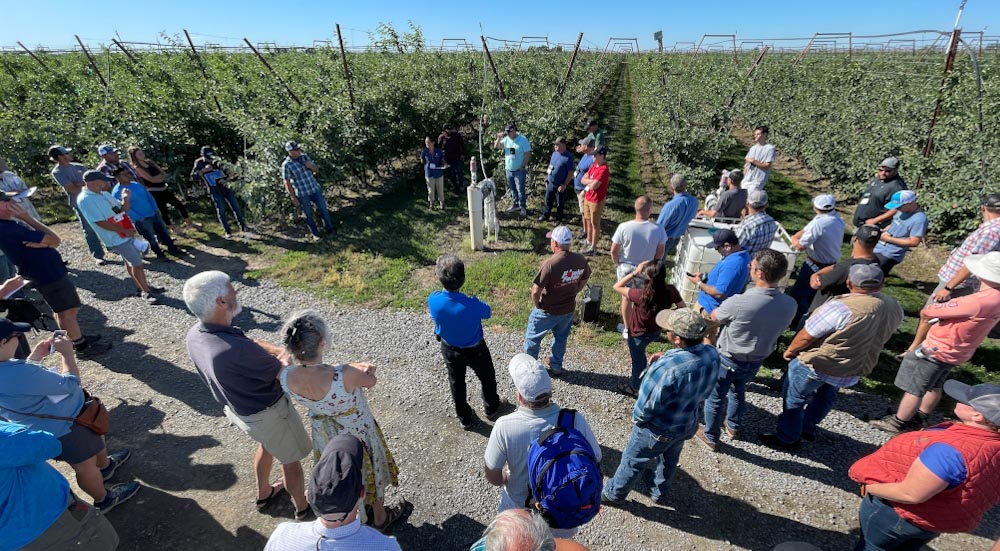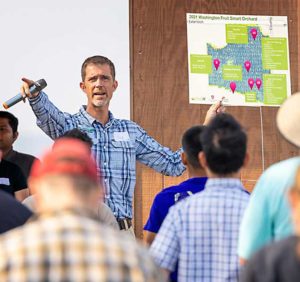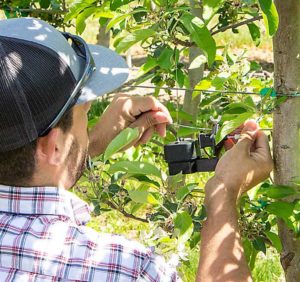
Growers from across the U.S. — and even a few from beyond — arrived in Central Washington this week for a tour organized by the International Fruit Tree Association.
Fittingly, the first stop on July 18 focused on Washington’s newest apple: WA 38, which is marketed as Cosmic Crisp. When the IFTA group last visited the region in 2017, the first growers were just planting WA 38, but now they’ve learned a lot more about how to grow the Washington State University-bred variety.
During a stop at a Douglas Fruit orchard in Pasco, area manager Garrett Henry talked with WSU Extension’s Bernardita Sallato about rootstock selection, tree training, balancing early cropping with growth, and how Henry and his team have improved their approach in more recent plantings.
The orchard included WA 38 blocks planted on B.9, B.10, and G.11 rootstocks, all in 2018 as sleeping eye trees, Henry said. Due to labor constraints, the young trees didn’t get all the training they needed right away, he said, which set the orchard back.
“I think if we execute correctly, we can fill the space in three to four years,” he said, adding that he thinks the training matters more than the rootstock choice, and “a nice finished nursery tree is going to save you a year.”

At planting now, they take all the branches back to 3- to 4-inch stubs, he said. If shorter than that, WA 38 can tend toward blind wood.
He also told the group that the new variety colors well, so they don’t use reflective mulch like they do in some other varieties, but they are very careful about sunburn, deploying either overhead cooling or shade netting.
The second stop visited high-density cherry plantings of Coral Champagne on Mazzard roots. Grower Denny Hayden said the 2017 and 2018 plantings were his attempt to bring cherries closer in spacing to apples, so he could use the same equipment. Trained to a V-trellis, the trees were planted with 8 feet between trees and 13-foot rows in 2017. “That’s pretty dense for Mazzard roots,” Hayden said. He uses a formal training system, bringing the laterals down to the wires, to keep the trees more dwarfing.
While many of his varieties are now planted on Gisela or Krymsk rootstocks, he opted to pair the far less precocious Mazzard with Coral to reduce its tendency to overset.
The cherries had been picked a few weeks prior, but during harvest, he has hundreds of workers in the orchards at once. It’s so busy, platforms would be in the way, he told the group. But he plans to use mechanized bloom thinning to keep the Corals — a heavy-setting variety — producing large, high-quality fruit. This year, after unprecedented snow in April put a damper on pollination, he didn’t need to, but the planar system should support mechanized thinning in the future, he said.
In the same orchard, he also showed the group a small trial of the dwarfing cherry rootstocks developed by Michigan State University. The roots are definitely dwarfing, but they’re not well-suited to the formal V-trellis system he trained them in, Hayden said. He suspects they would do much better in a denser, super spindle axe approach that keeps the fruiting structures shorter.
Cameron Nursery in nearby Eltopia hosted the tour group for lunch and tours of their production. Owner Todd Cameron said the nursery is trying to adjust to shifting industry demand and, overall, is reducing its capacity. There’s more complexity to tree orders today, with so many new rootstocks and varieties and the need to make site-specific combinations, so the nursery can no longer afford to produce trees on speculation, he said. Growers need to work with their nurseries to plan ahead on tree orders.
The final stop on the first day visited the Smart Orchard project, an effort organized by the Washington Tree Fruit Research Commission, Washington State University and tech company innov8.ag to bring many different sensor technologies and scientists to commercial research blocks to learn how these tools can benefit growers.
WSU’s Sallato and physiologist Lee Kalcsits shared what they’ve learned about soil mapping and plant water stress technologies, while Steve Mantle of innov8.ag talked about how he uses vision technology from Green Atlas to assess crop load through the season.
—by Kate Prengaman








Leave A Comment